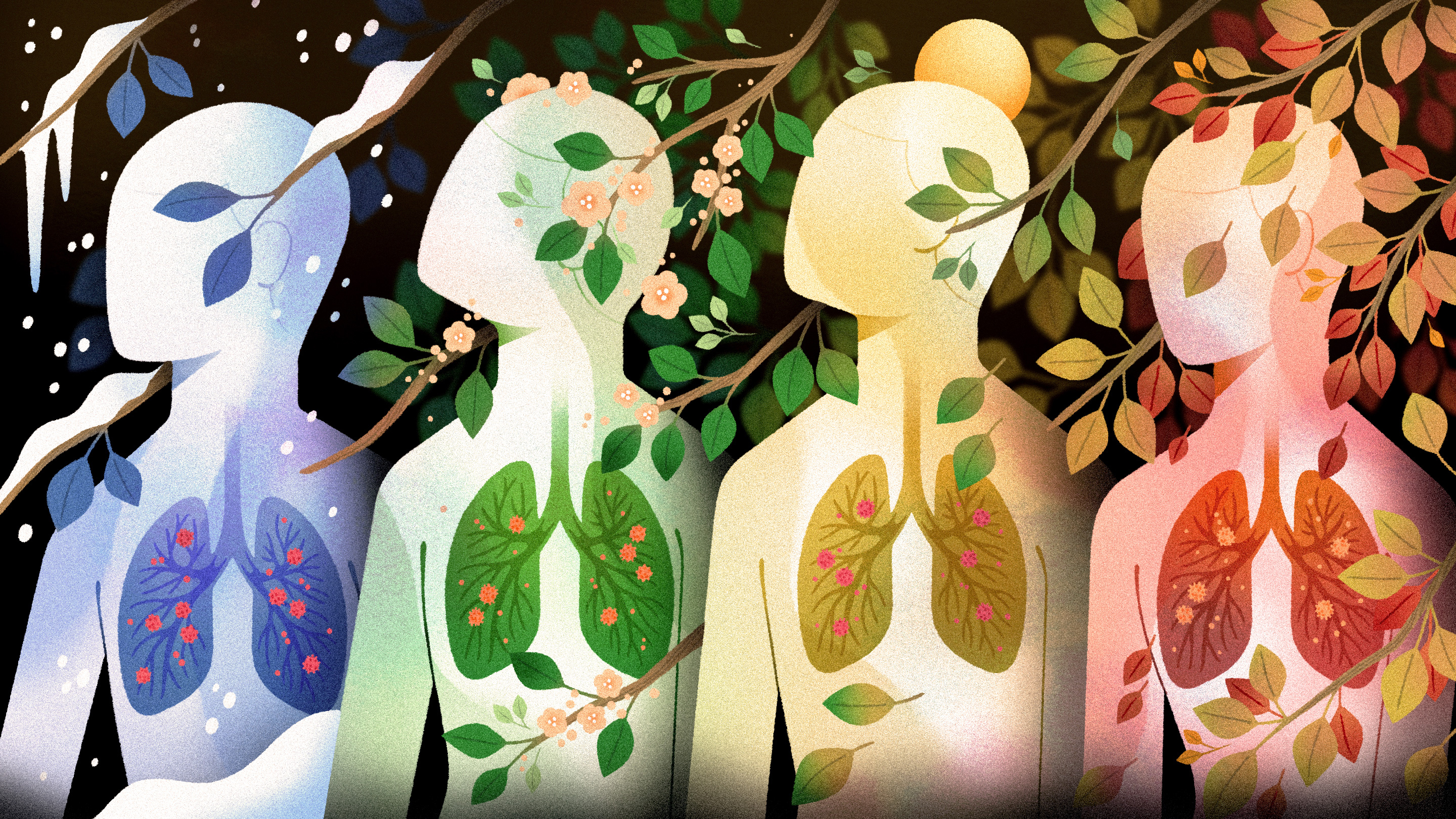How ‘Long COVID’ Keeps Us Sick

Maggie Chiang for Quanta Magazine
Introduction
Understanding the effects of the COVID-19 pandemic on the population means knowing more than just the total number of infections and deaths. As with many diseases, after the acute infection has passed, a constellation of symptoms known as sequelae can still linger. And while the end of the pandemic is finally coming into view, we’re still in the early stages of comprehending post-acute sequelae of SARS-CoV-2 infection, also referred to as “PASC” or “long COVID.”
But COVID is far from the only infectious disease to result in long-term symptoms. Understanding this newly identified chronic illness and its associated symptoms could be guided by, and inform our knowledge of, other instances of post-infectious sequelae.
How can a virus still cause problems even after it’s gone?
There are myriad ways that infectious agents — viruses, bacteria, parasites, fungi and prions — can do long-term damage to the host, directly or indirectly. For instance, damage from the initial infection may cause a cascade of host responses that result in pathology even after the acute infection has resolved. This is sometimes referred to as a “hit-and-run” mechanism of disease, as the infectious agent is often gone by the time any post-infectious damage appears. Alternatively, microbes can infect us and then linger in our bodies for months or years as either a persistent active infection or a persistent nonreplicating (latent) infection. These infections can cause long-term damage via several different means, including inducing inflammation that leads to tissue destruction, or reactivation of a latent pathogen that begins reproducing again in times of stress.
How serious are sequelae symptoms?
They can be very serious: One long-term outcome of infection with certain microbes is cancer. This can happen via integration, when viruses (or segments of the viral genome) become a part of the host’s genome, interrupting essential functions in infected cells.
We see this with the human papilloma virus, or HPV, which can cause completely asymptomatic infections, mild infections resulting in genital warts, or serious infections resulting in cancer. Fortunately, only relatively few types of HPV are oncogenic (cancer-causing), and you can guard against the most common types, HPV-16 and HPV-18, with the HPV vaccine. When the virus is integrated into the host chromosome, two viral genes — E6 and E7 — increase their expression, interfering with the work of the host’s tumor-suppressing proteins. These proteins, which usually shut down unregulated cell proliferation, are dysregulated, like brakes on a car that have been disabled. The host cells can then replicate unchecked, often resulting in cancer.
Nor is cancer the only serious long-term outcome of an infection. Streptococcus pyogenes, the bacterium that causes strep throat and scarlet fever, can also cause organ damage, particularly of the heart. An untreated infection may lead first to a condition called acute rheumatic fever, which typically presents with fever and arthritis weeks after the initial infection. While those symptoms generally resolve within another few weeks’ time, approximately half of all rheumatic fever patients also experience carditis — inflammation that can affect any area of the heart, potentially resulting in permanent damage. Rheumatic heart disease appears to be caused by a phenomenon called antigenic mimicry: Certain proteins on the surface of the streptococcus bacterium are similar in shape to the natural cardiac protein myosin, so when host antibodies are produced to protect against the streptococcus, they can inadvertently cross-react with host proteins and damage the heart.
What do the sequelae look like for COVID?
We are still working to develop a specific case definition of PASC, but most studies describe patients with symptoms including fatigue, headaches, joint pain, muscle aches and shortness of breath lasting months or longer after resolution of the acute infection. Some patients also seem to have long-term damage to the heart, lungs or other organs, which can lead to cognitive issues such as “brain fog,” depression, anxiety and issues with sleep. Up to one-third of COVID patients may still suffer from symptoms months after their initial infection, even if their symptoms were mild.
What do we know about how PASC works?
Currently there are numerous competing theories for how the SARS-CoV-2 virus may cause long-term symptoms. PASC may be a hit-and-run infection, potentially triggering inflammation that could do damage, or it could cause direct damage to tissues due to replication of the virus in targeted organs. It’s possible the virus may linger in reservoirs within the body, but there has been no prior documentation of persistent infection of the host by human coronaviruses, so this remains unproven.
What can I do if I think I have it?
This is also an ongoing area of study. A number of clinics have been established to work with patients diagnosed with PASC, but there are no specific treatments for the condition as a whole. Most approaches currently focus on managing symptoms and eliminating other conditions that may exacerbate the illness (such as anemia, pneumonia or cardiac conditions). There is some evidence that vaccination may help reduce symptoms, but we need additional studies to confirm that finding.
How hard is it linking sequelae to their original diseases?
Normally it’s difficult work, but the nature of the pandemic has actually made it easier for PASC.
In a typical setting (that is, not during an epidemic), a major limitation to making a causal link between a particular infection and a long-term sequel is our limited use of diagnostics. With PASC, we know that many individuals who suffer from issues after the resolution of acute symptoms had only a mild experience with COVID. If we weren’t in a pandemic, medical providers might not even have thought much of such symptoms, brushing them off as “just a cold” or a stomach bug.
Indeed, many of the other agents that are thought to cause long-term sequelae have similar nonspecific symptoms (fever, malaise or “feeling bad,” cough, nausea), or no outright symptoms at all. While some molecular types of HPV can cause genital warts, the oncogenic types rarely cause any symptoms. Most people only learn they are infected when a pap smear comes back positive for viral DNA. But in an epidemic, with testing more readily available and millions being carefully watched for the first sign of a fever or cough, commonalities are easier to spot, and recognition of the initial illness is more likely.
And while we may miss the post-infectious sequelae of endemic infections, we can also see the reverse: Many diseases with a proposed infectious origin still lack a definitive causal agent. Type 1 diabetes, for example, has long been suspected to have a viral trigger, with a family of viruses known as enteroviruses being a key possibility.
Can a given set of symptoms have more than one cause?
Unfortunately, yes. Many symptoms of long COVID are similar to those of myalgic encephalomyelitis/chronic fatigue syndrome: headaches, fatigue, “brain fog” and other cognitive issues; muscle and joint pain; depression and anxiety; and sleep disorders. It’s quite possible that a host of different infectious agents may produce a similar constellation of symptoms, making the determination of a definitive origin nearly impossible in the absence of an outbreak setting.
But for COVID at least, the answers are coming in. Over 60 clinics have opened throughout the country to treat and study PASC patients, and the National Institutes of Health has received over $1 billion to study the condition. And by elucidating the mechanisms by which SARS-CoV-2 may cause long-term damage, we hope not just to better treat PASC itself, but to improve our understanding of some of these other diseases as well.



